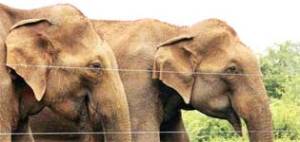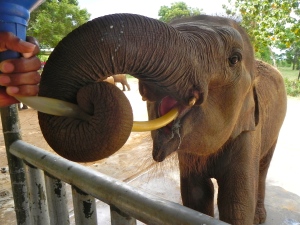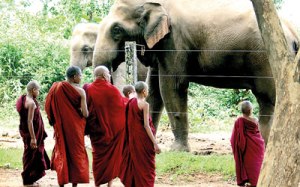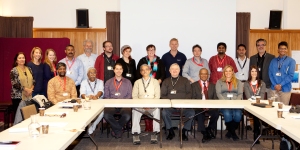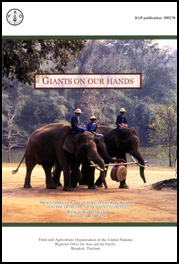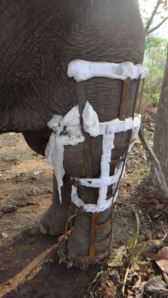Elephant Culling Debate in Sri Lanka
Recent comments by elephant expert Ajay Desai have raised some fundamental questions regarding the human management of wild elephants and the problems of human-elephant coexistence in Sri Lanka. At a public lecture titled “A Way Forward With Elephants”, Ajay Desai, co-chair of the IUCN/SSG Asian Elephant Specialist Group, considered culling as a means of resolving human-elephant conflict. Unsurprisingly, such a radical suggestion elicited response from other elephant experts (among whom lively debate always prospers!). Professor Charles Santiapillai, wrote this response published in The Island:
What is Ethnoelephantology? This new article provides an answer
This new article suggests an integrated, interdisciplinary approach to the study of human-elephant relations is emerging. It seeks to define the field of Ethnoelephantology in terms of the social and cognitive similarities between humans and elephants, the myriad ways in which human and elephant lives and landscapes are intertwined, and the combination of methodological perspectives from the social and the natural sciences. It explores conflict and coexistence in human-elephant relations through issues of captive elephant management, wild elephant conservation, and human-elephant conflict, reviewing cutting-edge research emerging from anthropology, geography, and history.
Locke, P. 2013. ‘Explorations in Ethnoelephantology: Social, Historical, and Ecological Intersections between Asian Elephants and Humans’ . Environment and Society: Advances in Research. 4, 79-97.
abstract:
Humans and elephants have lived together and shared space together in diverse ways for millennia. The intersections between these thinking and feeling species have been differently explored, for different reasons, by disciplines across the sciences, humanities, and social sciences. Such disciplinary divisions, predicated on oppositions of human-animal and nature-culture, are integral to the configuration of modernist thought. However, posthumanist and biocultural thinking questions the underlying epistemological conventions, thereby opening up interdisciplinary possibilities for human-animal studies. In relation to issues of conflict and coexistence, this article charts the emergence of an interdisciplinary research program and discursive space for human-elephant intersections under the rubric of ethnoelephantology. Recognizing continuities between the sentient and affective lifeworlds of humans and elephants, the mutual entanglements of their social, historical, and ecological relations, and the relevance of combining social and natural science methodologies, the article surveys recent research from anthropology, history, and geography that exemplifies this new approach.
Download this article from academia.edu: Explorations in Ethnoelephantology
Dr. Khyne U Mar’s Rufford-funded project on a captive elephant databank in Myanmar
Dr. Khyne U Mar is a world renowned elephant vet. Myanmar has more working elephants than any other country. They still play a major role in logging and detailed records are kept on every elephant. This provides a wealth of data for understanding, managing, and caring for elephants, which Dr. Mar has analyzed. More recently she has been overseeing a project to digitize these records to create a centralized databank. This page introduces us to Dr. Mar’s recent Rufford Foundation-funded project:
Establishment of Centralized Elephant Data Bank in Myanmar
Do Elephants Have Souls? by Caitrin Nicol in The New Atlantis
This is a truly excellent essay that asks how elephants confound the criteria we have constructed to support our purported uniqueness, that argues against the scientific prohibition of anthropomorphism that almost every elephant ethologist has been unable to resist, and which seriously wonders what it must be like, existentially, to be an elephant, an animal so physically unlike ourselves but mentally, morally and socially so similar.
http://www.thenewatlantis.com/publications/do-elephants-have-souls
Food, Ritual and Interspecies Intimacy in the Chitwan Elephant Stables
Photo essay in volume 2, issue 2 of The South Asianist, an open access journal produced by the Centre for South Asian Studies at the University of Edinburgh. Developed from a photographic exhibition at the University of Canterbury in October 2012, this essay documents feeding practices and sacrificial rituals at the government elephant stables in Chitwan, Nepal.
From coexistence to conflict: Electric fences for elephants in Sri Lanka
Jayantha Jayewardena reports on Prithiviraj Fernando’s research on elephants and electric fences on the borders of the Uda Walawe National Park. In the 1990s Elephants began frequenting an electric fence where they would interact with members of the public, receiving food, largely without conflict. Then, when the Department of Wildlife Conservation erected a second fence to separate the elephants from the humans, raiding began and a situation of coexistence became one of conflict. This story speaks to current thinking in human-elephant relations that is critical of fortress conservation models that try to separate the species.
For the full story see: Wild elephants, people and an electric fence
NZAsia report on the Symposium on Human-Elephant Relations in South and Southeast Asia
This two-day symposium at the University of Canterbury, brought together an international array of senior and junior researchers from across the natural sciences, the humanities, and the social sciences for an interdisciplinary exploration of the manifold aspects of the human-elephant relationship. Hosted by the Department of Anthropology and the New Zealand South Asia Centre (NZSAC), anthropologists, ecologists, geographers, historians, political scientists, Sanskritists, zoologists, and zoo elephant experts from Australia, France, Germany, India, New Zealand, Sri Lanka, the UK, and the USA met for an intensive meeting featuring dynamic presentations and vibrant discussion. The event provided a unique opportunity for productive debate across disciplinary boundaries on issues of welfare and conservation, history and coexistence, policy and practice, through which elephants have been variously bound up in human projects as weapons of war, emblems of prestige, symbols of divinity, objects of entertainment, icons of conservation, commodities for exchange, vehicles for labour, and intimate companions.
India’s premier elephant ecologist, Professor Raman Sukumar of the Indian Institute of Science gave the keynote lecture; a magisterial survey of the human-elephant relationship through the ages. His talk ranged from the archaeological evidence of the Indus Valley Civilization through to the post-colonial present; discussing the use of elephants in war, Sanskrit literature encoding expert knowledge about elephants, the emergence of the elephant-headed deity Ganesha, the political significance of elephants in the Mughal period, and the use of elephants in logging under British colonialism, concluding with remarks on the future prospects for captive and wild elephants in Asia. This was followed by the first of four sessions, on humans and elephants as mutually entangled species. Piers Locke (Canterbury) began the session with a proposal for an integrated approach to the study of human-elephant relations called ethnoelephantology, in which he recognized elephants as well as humans as ethnographic subjects. Maan Barua (Oxford) then discussed the role of elephant encounters, both real and virtual, as experienced in the lives of rural people and in mobilizing action for conservation, considering elephants not only in terms of use value, but also in terms of charismatic authority. Kierin Mackenzie (Canterbury) concluded the panel with a presentation on the application of ethnoecological methods in mapping traditional knowledge about environments, elephants, and interactions with humans.
The second panel, Humans and Elephants Through Time began with Thomas Trautmann (Michigan) reporting on his work developing a history of the ancient origins of mahoutship and the transmission of elephant knowledge through the Greek, Persian, Roman and Egyptian civilizations. Then Jane Buckingham (Canterbury) explored the significance of the elephant during the reign of the Mughal Emperor Akbar as a symbol of masculinity and power. Patrick Olivelle (Texas) detailed the contents of Kautilya’s Arthaśāstra as it pertains to knowledge of elephant behavior, elephant capture, elephant care, specialist roles, evidence for the trade in elephants and their ivory, and the challenges of interpretation. Finally, Amy Fletcher (Canterbury) discussed the implications of sequencing the woolly mammoth genome, how and why one might resurrect an extinct species, and what such a mooted project reveals about human desire and technology.
The third panel, Living With Elephants showcased recent anthropological work on the ethnography of captive elephant management. Nicolas Lainé (Paris West) analyzed songs used by ethnic Khamti mahouts in Assam, exploring their role in the mutual socialization of human and elephant as intimate working companions. Ingrid Suter (Queensland) discussed the results of an extensive survey of mahouts in Laos, exploring the variable conditions, expertise, and self-evaluations of those working in logging and those working in tourism. Nikki Savvides (Sydney) outlined the problems facing captive elephants in Thailand, focusing on the loss of traditional employment opportunities for human and elephant in Surin province. These papers were followed by two presentations dealing with welfare issues. Surendra Varma (Indian Institute of Science) summarized his extensive research in ten Indian states on the relations between elephant and mahout welfare in zoos, circuses, forest camps, temples, private ownership, and street begging. The panel concluded with Erin Ivory (Franklin Zoo), who explored the controversies and internal politics of elephant-keeping institutions in the western world.
The final panel, Sharing Space with Elephants was concerned with conflict and coexistence in South India and Sri Lanka, where solutions are sought to best accommodate the needs of human and elephant. Charles Santiapillai (Rajarata) presented the results of the 2011 Sri Lankan elephant survey, discussing the landscape modifications that facilitate the persistence of elephants on an island with limited habitat and a high human population density, whilst his colleague Shanmugasundaram Wijeyamohan (Rajarata) discussed new initiatives to monitor wild bulls and to alert local villagers to the presence of potentially dangerous wild elephants. Tarsh Thekaekara (Shola Trust) presented research from the Nilgiris of Tamil Nadu investigating the differential tolerance toward elephants of different human communities, the variety of ways in which elephants are perceived, their incursions mitigated, the main drivers of human-elephant conflict, and the significance of media reporting. In her absence, Piers Locke presented Ursula Münster’s paper (LMU Munich) on the contrasting case of human-elephant conflict in and around the Wayanad wildlife sanctuary, Kerala, which highlighted the social, historical and ecological entanglement of human and elephant, the latter locally recognized as persons in consonance with findings from animal behavioural science.
The points of intersection between the disciplines represented at the symposium made the case for future interdisciplinary approaches to researching human elephant relationships in South and Southeast Asia, yielding the prospect of new research collaborations and talk of new plans to support the needs of elephants, captive and wild. Symposium participants agreed to develop their papers for publication under the editorship of Piers Locke and Jane Buckingham.
This conference report also appears in volume 2, issue 2 of The South Asianist
-Piers Locke and Samantha Eason
On the problems facing Thailand’s elephants
An extremely weighty problem: Thailand’s elephants, once revered, are suffering many threats, ranging from deforestation to unscrupulous gangs
See: http://www.bangkokpost.com/news/local/352878/an-extremely-weighty-problem
The challenge of managing domesticated Asian elephants in Nepal – Fanindra R. Kharel
Here’s a link to the 2002 article on captive elephants in Nepal that appeared in Giants on Our Hands: Proceedings of The International Workshop on The Domesticated Asian Elephant, Bangkok, Thailand, 5 to 10 February 2001. It contains lots of useful information about the recent history of captive elephants in Nepal, including the establishment of the Khorsor Breeding Center, data on the declining wild elephant population, captive elephants held in public and private locations, and births of captive elephants.
The story of Babul, recovering from the attack of a wild male, from the Contact Zones blog
Here are a couple of Paul Kiel’s recent online field reports about an injured male called Babul, revealing some important insights about relations between wild and captive elephants sharing the same space, and about mahouts’ understanding of the ways that wild elephants respond to elephants who live with humans.
See: Leg Injuries, elephant leg braces and elephant management

